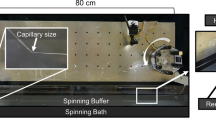Abstract
This article describes a new process for strengthening natural silk fibers. This process is simple yet effective for mass production of high strength silk fibers, enabled by drawing at a lower temperature and immediately heat setting at a higher temperature. The processing conditions were investigated and optimized to improve the strength. Silk fibers drawn to the maximum ratio at room temperature and then heat set at 200 °C show best tensile properties. Some salient features of the resulting fibers are tensile strength at break reaching 533±10.2 MPa and Young’s modulus attaining 12.9±0.57 GPa. These values are significantly higher than those of natural silk fibers (tensile strength increased by 44 % and Young’s modulus by 135 %). Wide-angle X-ray diffraction and FTIR confirm the transformation of silk I to silk II crystalline structure for the fiber obtained from this process. DSC and TGA data also provide support for the structural change of the silk fiber.
Similar content being viewed by others
References
J. Yao, H. Masuda, C. Zhao, and T. Asakura, Macromolecules, 35, 6 (2002).
H. C. DeáLong, J. Mater. Chem., 15, 4206 (2005).
M. M. R. Khan, H. Morikawa, Y. Gotoh, M. Miura, Z. Ming, Y. Sato, and M. Iwasa, Int. J. Biol. Macromol., 42, 264 (2008).
Y. Shen, M. A. Johnson, and D. C. Martin, Macromolecules, 31, 8857 (1998).
Z. Zhu, T. Imada, and T. Asakura, Mater. Chem. Phys., 117, 430 (2009).
Z. Zhu, K. Ohgo, and T. Asakura, Express Polym. Lett., 2, 885 (2008).
Z. Shao and F. Vollrath, Nature, 418, 741 (2002).
K. A. Trabbic and P. Yager, Macromolecules, 31, 462 (1998).
S.-W. Ha, A. E. Tonelli, and S. M. Hudson, Biomacromolecules, 6, 1722 (2005).
E. Marsano, P. Corsini, C. Arosio, A. Boschi, M. Mormino, and G. Freddi, Int. J. Biol. Macromol., 37, 179 (2005).
H.-J. Jin, S. V. Fridrikh, G. C. Rutledge, and D. L. Kaplan, Biomacromolecules, 3, 1233 (2002).
C. Zhao, J. Yao, H. Masuda, R. Kishore, and T. Asakura, Biopolymers, 69, 253 (2003).
T. Kameda, Y. Ohkawa, K. Yoshizawa, J. Naito, A. S. Ulrich, and T. Asakura, Macromolecules, 32, 7166 (1999).
V. J. Gupta, J. Appl. Polym. Sci., 83, 586 (2002).
M. Tsukada, G. Freddi, M. Nagura, H. Ishikawa, and N. J. Kasai, J. Appl. Polym. Sci., 46, 1945 (1992).
A. Martel, M. Burghammer, R. J. Davies, E. Di Cola, C. Vendrely, and C. J. Riekel, J. Am. Chem. Soc., 130, 17070 (2008).
T. Asakura, T. Yamane, Y. Nakazawa, T. Kameda, and K. Ando, Biopolymers, 58, 521 (2001).
H. Cao, X. Chen, L. Huang, and Z. Shao, Mater. Sci. Eng., C, 29, 2270 (2009).
C. Jiang, X. Wang, R. Gunawidjaja, Y. H. Lin, M. Gupta, D. Kaplan, R. Naikand, and V. Tsukruk, Adv. Funct. Mater., 17, 2229 (2007).
S.-W. Ha, Y. H. Parkand, and S. M. Hudson, Biomacromolecules, 4, 488 (2003).
M. Nagura, M. Urushidani, H. Shinohara, and H. Ishikawa, Kobunshi Ronbunshu, 35, 81 (1978).
G. Freddi, P. Monti, M. Nagura, Y. Gotohand, and M. Tsukada, J. Polym. Sci. Pt. B-Polym. Phys., 35, 841 (1997).
J. Magoshi, Kobunshi Ronbunshu, 31, 765 (1974).
M. Li, W. Tao, S. Kugaand, and Y. Nishiyama, Polym. Adv. Technol., 14, 694 (2003).
H. Ishikawa, M. Tsukada, I. Toizume, A. Konda, and K. Hirabayashi, Sen-I Gakkaishi, 28, 91 (1972).
M. Tsukada, M. Obo, H. Kato, G. Freddi, and F. J. Zanetti, J. Appl. Polym. Sci., 60, 1619 (1996).
I. C. Um, C. S. Ki, H. Kweon, K. G. Lee, D. W. Ihm, and Y. H. Park, Int. J. Biol. Macromol., 34, 107 (2004).
Y.-Q. Zhao, H.-Y. Cheung, K.-T. Lau, C.-L. Xu, D.-D. Zhao, and H.-L. Li, Polym. Degrad. Stabil., 95, 1978 (2010).
Author information
Authors and Affiliations
Corresponding author
Rights and permissions
About this article
Cite this article
Fang, X., Wyatt, T., Wu, J. et al. An effective and simple process for obtaining high strength silkworm (Bombyx mori) silk fiber. Fibers Polym 16, 2609–2616 (2015). https://doi.org/10.1007/s12221-015-5170-8
Received:
Revised:
Accepted:
Published:
Issue Date:
DOI: https://doi.org/10.1007/s12221-015-5170-8




